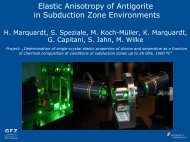High-pressure chemistry of nitride-based materials
High-pressure chemistry of nitride-based materials
High-pressure chemistry of nitride-based materials
You also want an ePaper? Increase the reach of your titles
YUMPU automatically turns print PDFs into web optimized ePapers that Google loves.
uilt up by SiN 4 tetrahedra. The hypothetical wII-Si 3 N 4 ,<br />
which exhibits the same structural motif, is expected to be<br />
about 8% denser than b-Si 3 N 4 . Most <strong>of</strong>ten, however, higher<br />
density is achieved by higher coordination <strong>of</strong> the atoms. The<br />
standard example in silica <strong>chemistry</strong> is the transition from<br />
quartz (or coesite) to stishovite, which adopts the rutile<br />
structure, in which all Si atoms are octahedrally-coordinated.<br />
The spinel structure <strong>of</strong> Si 3 N 4 is the corresponding example in<br />
silicon <strong>nitride</strong> <strong>chemistry</strong>. While not all Si atoms gain six-fold<br />
coordination, the ratio between the tetrahedra and octahedra<br />
is 1 : 2 and the average coordination (5.33) is 33% higher than<br />
in the ambient <strong>pressure</strong> modification <strong>of</strong> b-Si 3 N 4 .<br />
In the following section we will outline the computational<br />
strategy used to explore the phase space for suitable<br />
candidate structures that might appear at high-<strong>pressure</strong>.<br />
Although this method is not exhaustive—nature may display<br />
even more richness than we can think <strong>of</strong>—it is nevertheless<br />
predictive.<br />
6.2 Computational approach<br />
The standard computational approach in the search for new<br />
high-<strong>pressure</strong> modifications is to compute a manifold <strong>of</strong><br />
crystal structures and access the enthalpy as a function <strong>of</strong><br />
<strong>pressure</strong>. In a binary system, we build a library <strong>of</strong> structures<br />
consisting <strong>of</strong> n cations and m anions. Note that in searching<br />
structural libraries, neither cations nor anions have to be <strong>of</strong> the<br />
same kind. Though the most simple composition is indeed<br />
A n X m , the spinel structure A 2 BX 4 , adopted for Si 3 N 4 , provides<br />
a good example where one has to think much more broadly.<br />
Next, we compute every hypothetical polymorph for the<br />
composition, and we are interested in optimizing all its<br />
structural parameters. Some care has to be taken as sometimes<br />
large distortion <strong>of</strong> the structure may appear and need to be<br />
handled appropriately. Furthermore, symmetry constraints<br />
may inhibit relaxation towards a state <strong>of</strong> lower energy.<br />
Therefore, it is <strong>of</strong>ten a good idea to check the validity <strong>of</strong> a<br />
new possible structure by calculating a supercell, without<br />
symmetries, or to perform a short ab initio molecular dynamic<br />
simulation. Once the lowest energy structure for a polymorph<br />
is computed, its energy and volume can be compared with<br />
those <strong>of</strong> other modifications. Hence, by relying on the internal<br />
energy <strong>of</strong> the ideal crystal we have, in principle, established the<br />
ground state structure for a given composition.<br />
For every structure <strong>of</strong> interest we calculate the energy H for<br />
a series <strong>of</strong> volumina around the minimum (see Fig. 14). For<br />
one, this allows us to extract the bulk modulus B 0 <strong>of</strong> a<br />
structure by fitting the energy–volume (E–V) data to an<br />
equation-<strong>of</strong>-state (EOS). Secondly, we use the E–V data to<br />
calculate an enthalpy–<strong>pressure</strong> state function. The <strong>pressure</strong> p is<br />
extracted from the E–V graph by numerical differentiation: p =<br />
2hE/hV and the enthalpy according to H = E 2 pV. Most<br />
<strong>of</strong>ten, an appropriate equation-<strong>of</strong>-state (EOS) function can be<br />
used as well to extract the <strong>pressure</strong> from the E–V data. The<br />
EOS, however, is one parameterization function for a wide<br />
<strong>pressure</strong> range. The spline function, on the other hand, is much<br />
more robust if the system changes its behavior under<br />
compression, e.g., by distortions or displacive phase transformations.<br />
Hence, using splines typically gives a more accurate<br />
Fig. 14 Top-left: Energy–volume (E–V) diagram for a given composition<br />
with two crystalline phases, a and b, respectively. Once an<br />
optimized structure is found, the energy is calculated for a series <strong>of</strong><br />
volumes around the minimum. Note that the constraint <strong>of</strong> constant<br />
volume may still allow a change in the ratio <strong>of</strong> lattice constants. Top<br />
right: The E–V data is used to calculate an enthalpy–<strong>pressure</strong> state<br />
function and to generate a H–p diagram. The crossing <strong>of</strong> the two lines<br />
for a and b defines equal enthalpy and the point <strong>of</strong> phase transition,<br />
given unlimited time for equilibration. Bottom: In making the<br />
enthalpy–<strong>pressure</strong> data more comprehendable, it is good practice to<br />
choose a reference structure and plot the difference in enthalpy DH as a<br />
function <strong>of</strong> <strong>pressure</strong> p. Note that in our example, the enthalpy only<br />
appears to be a linear function <strong>of</strong> <strong>pressure</strong>, because <strong>of</strong> the large ratio<br />
between the bulk modulus and the <strong>pressure</strong> scale.<br />
value for p. By comparing the enthalpy–<strong>pressure</strong> state<br />
functions <strong>of</strong> several polymorphs, we are now able to predict<br />
the phase with lowest enthalpy H for a given <strong>pressure</strong> p. Itis<br />
good practice to plot enthalpy differences with reference to a<br />
given phase (<strong>of</strong>ten the ground state). This makes the<br />
transformation <strong>pressure</strong>s p more easily accessible, because<br />
the crossing <strong>of</strong> the curves within the enthalpy–<strong>pressure</strong> (DH–p)<br />
diagram appear at a larger scale. With the assumption that<br />
contributions <strong>of</strong> entropy to the free enthalpy are small in<br />
comparison to enthalpy differences, we calculate that the<br />
phase with lowest enthalpy H will be adopted for a given<br />
<strong>pressure</strong> p, if thermodynamic equilibrium can be achieved. The<br />
transition <strong>pressure</strong> can also be calculated from the slope <strong>of</strong> a<br />
common tangent to the E–V curves <strong>of</strong> the different phases.<br />
Generation <strong>of</strong> a DH–p diagram, however, has the advantage <strong>of</strong><br />
allowing the easy estimation <strong>of</strong> the uncertainty in p, if an<br />
uncertainty in DH—say due to the approximation DG # DH—<br />
is given.<br />
Treating enthalpy DH and free enthalpy DG on an equal<br />
footing has its limitations though. It is important to note that<br />
the discussion <strong>of</strong> the differences in enthalpies is only relevant at<br />
absolute zero. It can be justified because the additional entropy<br />
term TDS is typically small in comparison to the much larger<br />
variation <strong>of</strong> DH within a few GPa <strong>pressure</strong>. The transformation<br />
<strong>of</strong> one phase into another, or more generally between<br />
educts and products, is then governed only by enthalpy.<br />
However, if entropy is an important property <strong>of</strong> only one <strong>of</strong><br />
the participating phases, entropy needs to be taken into<br />
account. Such a situation arises, for example, if one <strong>of</strong> the<br />
products or educt is a gaseous species or if a phase assemblage<br />
may transform-to or develop-from a solid solution under<br />
<strong>pressure</strong>.<br />
1004 | Chem. Soc. Rev., 2006, 35, 987–1014 This journal is ß The Royal Society <strong>of</strong> Chemistry 2006





